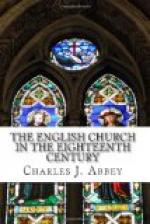[Footnote 473: Sec. 62.]
[Footnote 474: ’Address to the Clergy.’—Wesley’s Works, 492.]
[Footnote 475: Coleridge seems to have read H. More with much enjoyment.—Aids to Reflection, i. 106-10. ‘Occasional draughts,’ Channing writes, of More and other Platonists, ’have been refreshing to me.’ ... Their mysticism was noble in its kind, ’and perhaps a necessary reaction against the general earthliness of men’s minds. I pardon the man who loses himself in the clouds, if he will help me upwards.’—W.E. Channing’s Correspondence 338.]
[Footnote 476: Quoted by Bishop Berkeley, Theory of Vision, pt. i. Sec. 116.]
[Footnote 477: Schlosser, History of the Eighteenth Century, chap. 1. i. Horsley’s Charges, 86. Quarterly Review, July 1864, 70-9.]
[Footnote 478: Warburton’s Works, iv. 568.]
[Footnote 479: ’Letter to the Bishop of Gloucester.’—Wesley’s Works, ix. 151.]
[Footnote 480: Dedication to his Three Sermons, quoted by H.S. Skeats, History of the free Churches, 333.]
[Footnote 481: W. Roberts, Memoirs of Hannah More, i. 500, ii. 61, 70, 110.]
[Footnote 482: R.A. Vaughan’s Hours with the Mystics, ii. 391.]
[Footnote 483: C. Leslie, ’Snake in the Grass.’—Works, iv. 21.]
[Footnote 484: Dr. Sherlock, On Public Worship, chap. iii. Sec. 1, 4.]
[Footnote 485: Warburton’s ’Alliance.’—Works, 1788, iv. 53.]
[Footnote 486: Tatler, No. 257.]
[Footnote 487: Canon Curteis remarks of the early Quakers, ’What was urgently wanted, and what Christ (I think) was really commissioning George Fox and others to do, was not a destructive, but a constructive work,—the work of breathing fresh life into old forms, recovering the true meaning of old symbols, raising from the dead old words that needed translating into modern equivalents.’—G.H. Curteis, Dissent in Relation to the Church of England, 268.]
[Footnote 488: C. Leslie, ’Defence, &c.’—Works, v. 164.]
[Footnote 489: C. Leslie, Works, iv. 428.]
[Footnote 490: R. Barclay’s Apology for the Quakers, 259.]
[Footnote 491: No doubt some forms of Quakerism (for in it, as in every form of mystic theology, there were many varieties) lost sight almost altogether of any idea of atonement. Cf. British Quarterly, October 1874, 337; C. Leslie, ’Satan Disrobed.’—Works, iv. 398-418; id. v. 100.]
[Footnote 492: M.J. Matter, Histoire du Christianisme, iv. 343.]
[Footnote 493: Boswell’s Life of Dr. Johnson, ii. 456.]
[Footnote 494: Southey’s ‘Letters,’ quoted in Quarterly Review, 98, 494.]
[Footnote 495: ’I fancy that most of the Churches need to learn and receive of one another; and I have often wished that the zealous Methodist, for instance, who lives so much in action and in the atmosphere of religious excitement, could sometimes enter thoroughly into the spirit of the more religious Friends.’—H.H. Dobney, Free Churches, 106.]




